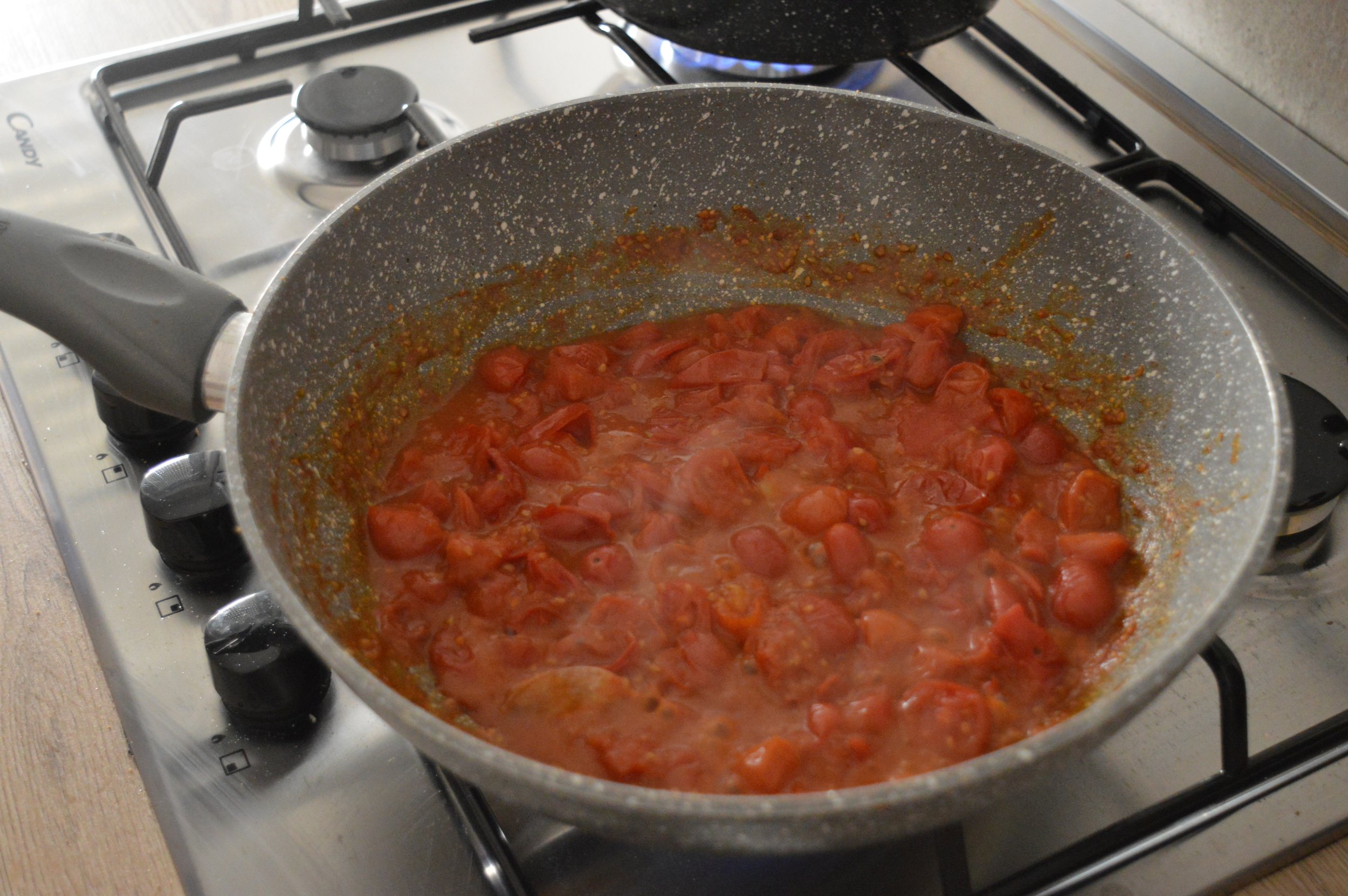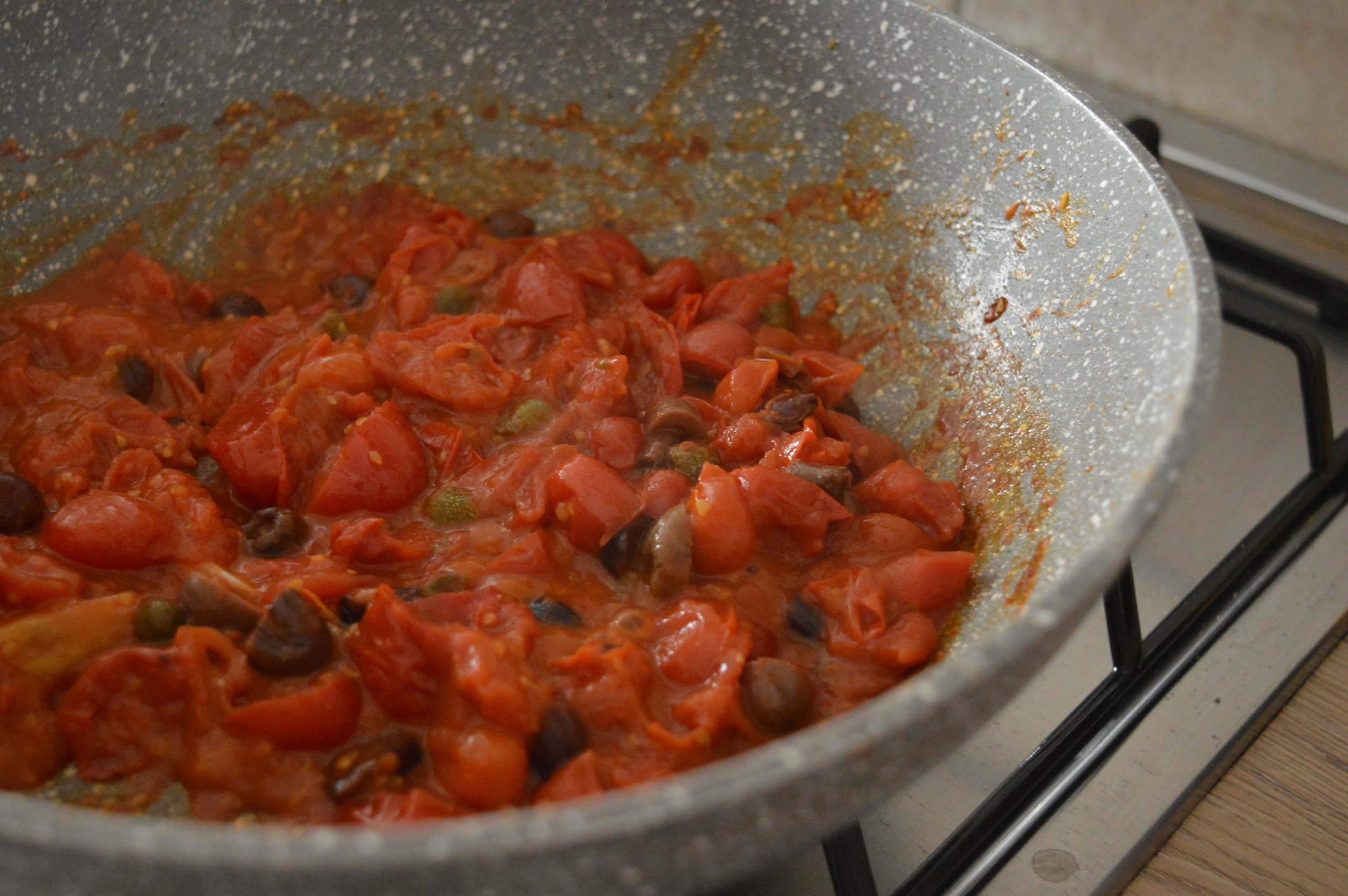Spaghetti alla puttanesca
Opinion, but also likely a fact: if you were to conduct a poll entitled “Best Sounding Foreign Language,” I’d bet you anything that Italian would come out on top. French may be elegant, Spanish rhythmic, and Japanese lilting, but Italian — full of rolling Rs, vowels, and double consonants — takes the cake. It’s a sing song-y, musical sort of language that manages to transform even the most mundane, unremarkable of words into something pleasing to the ear. Example: years ago, a friend of mine taking beginner Italian commented on how nice the word “ascella” (ah-SHELL-ah) sounded — I mean, I would name my kid Ascella! — only to learn that it meant, erm, armpit. The word zanzara (zahn-ZAH-rah) is the word for mosquito, the peskiest of insects, allora (ah-LOR-ah) signifies the humdrum English words of well/so, and pozzanghera (poh-ZAHN-geh-rah), is the glorious, double Z word to describe a commonplace rain puddle.
I’ll give you a second now to pronounce all of those outloud.
My favorite part about Italian, though? Once you start to learn and make sense of the delightful sounding words around you, you find that the language has a certain element of humor to it, especially when it comes to food. if someone is a big eater, for example, they’re known as a buona forchetta, or a good fork. The sauce-catching cut of pasta called orecchiette actually means little ears, referring to their round, hollow shape; slender linguine translates to little tongues, twisty strozzapreti means prieststranglers (don’t ask me about the origins of that one), and calzone means pantleg. The classic Roman dish saltimbocca means “jump in mouth,” referring to the dish’s mix of flavors; tiramisu’ translates to “pick me up,” referring to the elements of caffeine and chocolate in the dessert.
And today’s recipe for spaghetti alla puttanesca? Just when you thought it couldn’t get any stranger than “priest stranglers,” puttanesca comes from the word puttana, meaning — no joke — prostitute. Some believe the moniker comes from the word “puttanata,” or rather a pasta that was born by throwing together whatever was on hand without much thought (puttanata is an all-purpose sort of profanity). There are those who say that the dish is quick and spicy, much like the ladies of the night, and others still who theorize that this Neapolitan primo was invented in one of many bordellos in the Naples working-class neighbourhood of Quartieri Spagnoli. In any case — its an eyebrow raiser of a name.
Whatever the origins of puttanesca, it is one of my very favorite ways to eat pasta, which means a lot coming from a dedicated pasta fan like myself. With it being The Best Season of the Year and all, I’ve made a summery spaghetti alla puttanesca, one where fresh cherry tomatoes take the place of the usual tinned tomatoes, cooked until delightfully juicy, bursting, and saucy. A few cloves of garlic and a chili or two infuse the sauce, helped along by a few sneaky, umami-rich anchovies that melt into the olive oil and vanish. A handful of briny, meaty olives and punchy capers gives the dish even more oomph — this is a very in-your-face-, flavor packed dish — and a little parsley balances out this team of strong flavors out with a little freshness. It’s a speedy dish to make, too, meaning not much time spent over the stove — just what we want with these new record breaking heat waves across Europe.
On a closing note, heres a few more entertaining words from The Best Foreign Language to describe this spaghetti alla puttanesca, just because:
Buonissimo - buon-EE-see-moh - delicious
Piccante - pee-KAHN-tay - spicy
Squisito - skwee-ZEE-toh - exquisite
Spaziale - spah-ZEE-ah-lay - out of this word
Saporito- sah-POH-ree-toh - flavorful
A couple of notes: Feel free to use any kind of long thin pasta you want here — spaghetti is the classic choice, but bucatini or fettuccine would work fine as well. The classic choice of olives are Gaeta olives, but kalamata olives or even black olives (which may be easier to find) also work well. Finally, I have provided two options here — one for fresh tomatoes (as it is summer, after all!) and also one for canned tomatoes during the other three seasons. Feel free to up the amount of chili, capers, olives, and anchovies depending on your tastes. Finally, if you want to make this dish more substantial, add in two cans of drained tuna (packed in oil) to the tomatoes when you add the olives and capers.
Looking for more pasta recipes? Click here.
SPAGHETTI ALLA PUTTANESCA
Serves 4.
Ingredients:
3/4 lb (336 grams) spaghetti
2 cloves garlic, peeled and smashed
2 dried chili peppers
1 ounce (28 grams) anchovies, packed in oil
2 1bs (1 kg) cherry tomatoes, halved - or - 2 cans (800 grams) peeled tomatoes whole tomatoes
1 tablespoon capers, rinsed of salt
1/2 cup (100 grams) Gaeta olives, halved
1 large handful of parsley, chopped
Olive oil
Salt and pepper to taste
Directions:
1. Generously coat the bottom of a large skillet with olive oil and heat over a medium-low flame. Add the garlic cloves and dried chili peppers. Once the garlic is fragrant, toss in the anchovies. Let the anchovies melt into the olive oil, stirring frequently.
2. If using cherry tomatoes: add the tomatoes to the pan with the melted anchovies, garlic, and chili, seasoning them with a little salt. Let them cook down, using your spoon here and there to help smash them and make them nice and saucy. Cook the the tomato sauce until the tomatoes have released their liquid and are soft and burst.
If using canned tomatoes: add the crushed peeled tomatoes to the pan, breaking them up further with a spoon. Bring the tomatoes to a bubble, and then lower the flame. Cook until the sauce is thickened over low heat, about 20-25 minutes.
3. Whatever kind of tomatoes you’ve used, stir the capers, olives, and parsley in to the sauce. Fish out the garlic cloves and chili. Taste and season with salt, if needed.
4. Once the sauce is ready to go, cook your spaghetti in a pot of salted, boiling according to package directions for al dente — save a bit of the pasta water. Drain the pasta and toss it with your sauce over low heat for about 30 seconds, adding a bit of starchy pasta water if needed. Divide up the pasta among four plates, garnish with more parsley, and eat immediately with gusto.


![DSC_0695[1].JPG](https://images.squarespace-cdn.com/content/v1/5e4a5d2f4e209873477bec60/1658149304590-7CDXATMSDGXUXYX1C56X/DSC_0695%5B1%5D.JPG)


